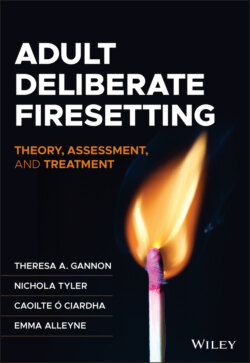Читать книгу Adult Deliberate Firesetting - Theresa A. Gannon - Страница 25
Limitations of the Literature and the Current Review
ОглавлениеIn summarising the literature, we have attempted to give greater weight to high-quality empirical sources as well as high-quality reviews synthesising the existing literature. Despite these aims, we have also relied in places on less robust studies, especially where those studies are more recent and have not been incorporated into past reviews.
A limitation of the adult firesetting literature to date has been the lack of comparison groups or the use of only one comparison group. As a result, it is not always possible to examine what differentiates individuals who have set fires from the wider community and from other justice-involved individuals. Additionally, the literature on adult firesetting has often focused on individuals who have a mental disorder and a history of firesetting. Given the theoretical and empirical links between psychopathology and firesetting, this focus is unsurprising. However, the sampling of individuals with a mental disorder or those without also likely reflects a pragmatic decision in terms of the population to which researchers have had access. As a result, studies of institutionalised individuals have often focused on just one type of institutional setting, either prison (e.g., Ó Ciardha et al., 2015a) or secure mental health (e.g., Wyatt et al., 2019). We have attempted to bring together the results of these studies in reviewing the available literature in this chapter and are most confident in results that appear consistent across settings.
Most psychological research on the characteristics or clinical features of individuals who set fires has been conducted in so-called WEIRD countries (i.e., Western, educated, industrialised, rich and democratic), particularly majority Anglophone as well as countries in the north of Europe. Research has focused less on a global picture of this phenomenon. Additionally, research conducted in WEIRD countries has not typically disaggregated findings to examine the generalisability of findings to ethnic minorities or indigenous populations within those countries. One exception to this trend was a recent study by Ellis-Smith et al. (2019), which examined differences in some offence characteristics (and criminal justice system outcomes) between Aboriginal and non-Aboriginal Australians who had set fires. Gannon et al. (2012) highlighted how cross-cultural differences in the use of fire and of education in its use may need to be accounted for in models of deliberate firesetting. This cross-cultural perspective remains lacking from much of the research summarised in this chapter.
